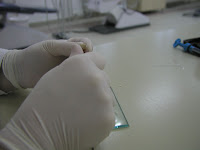The ISO4049 standard explains in detail how the depth of cure is measured and what is minimum depth that composites must have in order to comply with this standard. This simple procedure does not require sophisticated equipment and may be done in every dental office. It allows testing and comparison of materials and light curing units. Even if there is a radiometer to check the light intensity, it is recommended to measure the actual thickness of the composite cured by a a particular light curing unit.
Here is what we need:
Here is what we need:
- composite
- light curing unit
- cylindrical moulds (6 mm thick and 4-5 mm in diameter), originally it should be stainless steel, but plastic straws cut into moulds of this size may be used as well
- glass slab
- Mylar strips
- plastic filling instrument
- spatula or scalpel
1. Place the mould on the glass slab and fill it with composite.
2. Place the Mylar strip on top of the composite.
3. Light-cure the composite according the manufacturer's instructions (i.e. 40 s using a conventional or 20 s using a high-power halogen or LED light).
4. Discard the Mylar strip and remove the cured material from the mould.
5. Peel off the uncured material from the bottom side of the sample using the spatula or scalpel.
6. Measure the remaining thickness of the sample and divide this number by two. The ISO 4049 standard requires that the result should be at least 1.5 mm for non-opaque shades and 0.5 mm for opaque shades.
2. Place the Mylar strip on top of the composite.
3. Light-cure the composite according the manufacturer's instructions (i.e. 40 s using a conventional or 20 s using a high-power halogen or LED light).
4. Discard the Mylar strip and remove the cured material from the mould.
5. Peel off the uncured material from the bottom side of the sample using the spatula or scalpel.
6. Measure the remaining thickness of the sample and divide this number by two. The ISO 4049 standard requires that the result should be at least 1.5 mm for non-opaque shades and 0.5 mm for opaque shades.
















